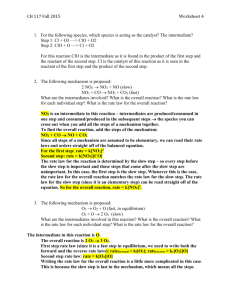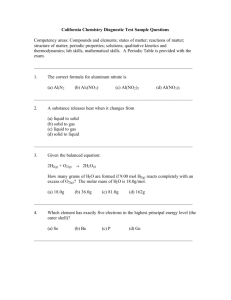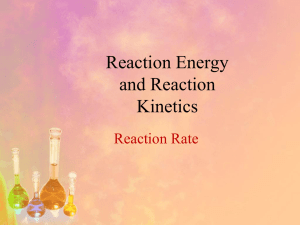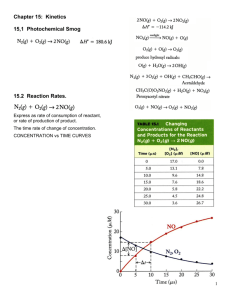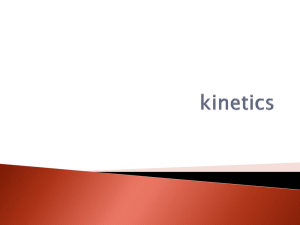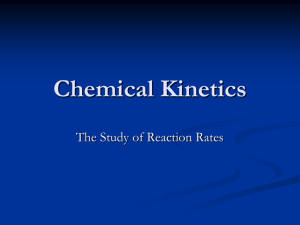Chapter 15 Powerpoint
advertisement
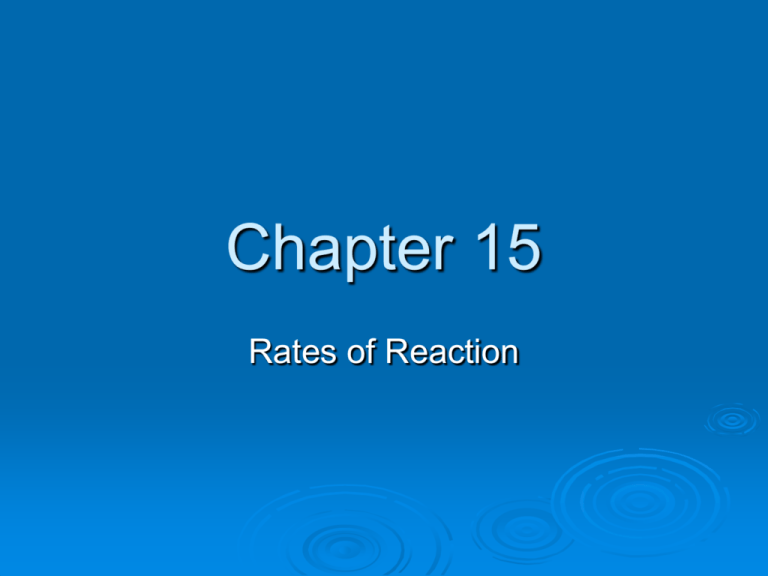
Chapter 15 Rates of Reaction Overview Reaction Rates Definition of Reaction Rates Experimental Determination of Rate Dependence of Rate on Concentration Change of Concentration with Time Temperature and Rate; Collision and TransitionState Theories. Arrhenius Equation Reaction Mechanisms Elementary Reactions Rate Law and the Mechanism Catalysis Definition of Reaction Rate Reaction rate = increase in concentration of product of a reaction as a function of time or decrease in concentration of reactant as a function of time Rate Equation For the reaction: A+ 2B 3C conc change A [ A ] Rate A time change t [ A ]2 [ A ]1 t 2 t1 Rate Equation Concentration vs Reaction Time A + 2B --> 3C Concentration, M 0.090 Init Rate 0.045 Inst. Rate Ave. Rate 0.000 0 250 500 Tim e, s Rates are expressed as positive numbers. For the reaction in the graph we have: [ A ] RA t RB [B] t RC [C ] t Reaction Rates and Stoichiometry A + B C; RC = RA = RB. A + 2B 3C; For the general reaction: aA + bB cC + dD . 1 1 R A RB RC 2 3 a a a R A RB R C RD b c d Calculate the rate of decomposition of HI in the reaction: 2HI(g) H2(g) + I2(g). Given: After a reaction time of 100 secs. the concentration of HI decreased by 0.500 M. the reaction 2A + 3B 4C + 2D; determine the rates of B, C and D if the rate of consumption of A is 0.100 M/s. For Factors that Affect Reaction Rates Nature of reactants Concentrations of reactants Temperature Presence or absence of a catalyst a substance that increases the rate of reaction without being consumed in the reaction. Surface area for heterogeneous reactions. Rate Laws and Reaction Order Rate Law – an equation that tells how the reaction rate depends on the concentration of each reaction. Reaction order – the value of the exponents of concentration terms in the rate law. the reaction: aA + bB cC + dD, the initial rate of reaction is related to the concentration of reactants. For R = k[A]m[B]n Varying the initial concentration of one reactant at a time produces rates, which will lead to a determination of exponents. The rate law describes this dependence: R = k[A]m[B]n where k = rate constant and m and n are the orders of A and B respectively. m = 1 (A varied, B held constant) gives R = k’[A]. Rate is directly proportional to [A]. Doubling A doubles R m = 2 (A varied, B held constant) gives R = k’[A]2. The rate is proportional to [A]2. Doubling A quadruples R. Determine order of each reactant: HCOOH(aq) + Br2(aq) 2H+(aq) + 2Br(aq) + CO2(g) R = k[Br2] The formation of HI gas has the following rate law: R = k[H2][I2]. What is the order of each reactant? Problem Determine the reaction orders for the reaction indicated from the data provided. A + 2B + C Products. [A]o 2.06 0.87 0.50 1.00 [B]o 3.05 3.05 0.50 0.50 [C]o 4.00 4.00 0.50 1.00 Ro 3.7 0.66 0.013 0.072 Problem Determine the reaction order for each reactant from the table. BrO3-(aq)+5Br(aq)+6H+(aq)3Br2(aq)+3H2O(l) [BrO 3 ]o 0.10 0.20 0.10 0.20 [Br]o 0.10 0.10 0.30 0.10 [H+]o 0.10 0.10 0.10 0.15 Ro 1.2 2.4 3.5 5.4 First–Order Reaction: Integrated Rate Law For a first order reaction, Rate = [A]/t = k[A] Linear Graph, In [A] vs time Equation of the line Concentration vs time ln[ A ] kt ln[ A ]o ln [A] kt [ A ]o Problem Calculate the concentration of N2O remaining after its decomposition according to 2N2O(g) 2N2(g) + O2(g) if it’s rate is first order and [N2O]o = 0.20M, k = 3.4 s1 and T = 780°C. Find its concentration after 100 ms. Problem When cyclohexane (let's call it C) is heated to 500 oC, it changes into propene. Using the following data from one experiment, determine the first order rate constant.: Half-Life: First Order Reaction Half-life of First order reaction, t1/2 = 0.693/k. the time required for the concentration of the reactant to change to ½ of its initial value. i.e. at t1/2 , [A] = ½ [A]o 1 / 2[ A]o ln k t1/ 2 [ A]o 1 ln k t1/ 2 2 t1/ 2 0.693 / k Problem For the decomposition of N2O5 at 65 °C, the half-life was found to be 130 s. Determine the rate constant for this reaction. Second–Order Reactions: Integrated Rate Law Rate law: R = k[A]2 Plot 1 [ A ]t of vs. t gives a straight line with a slope of k. Equation Half-life of the Line: is: 1 t1/ 2 k [ A ]o 1 1 kt [ A ]t [ A ]o Problem At 330°C, the rate constant for the decomposition of NO2 is 0.775 L/(mol*s). If the reaction is second-order, what is the concentration of NO2 after 2.5x102 s if the starting of concentration was 0.050 M? Zero–Order Reactions: Integrated Rate Law Rate law: R = k[A]0 Plot of [A] vs. t gives a straight line with a slope of -k. Equation Half-life of the Line: [A] = kt - [Ao] is: t½ = [Ao] / 2k Reaction Mechanisms Give insight into sequence of reaction events leading to product (reaction mechanism). Each of the steps leading to product is called an elementary reaction or elementary step. Consider the reaction of nitrogen dioxide with carbon dioxide which is second order on NO2: NO2(g) + CO(g) NO(g) + CO2(g) Rate = k[NO2]2. Rate law suggests at least two steps. A proposed mechanism for this reaction involves two steps. Step 1 Step 2 Overall 2NO2(g) NO3(g) + NO(g) NO3(g) +CO(g) NO2(g) + CO2(g) NO2 + CO NO + CO2 NO3 is a reaction intermediate = a substance that is produced and consumed in the reaction so that none is detected when the reaction is finished. The elementary reactions are often described in terms of their molecularity. Unimolecular One particle in elementary. Bimolecular = 2 particles and Termolecular = 3 particles Rate Laws and Reaction Mechanisms Overall reaction order is often determined by the rate determining step. Use rate law of limiting step; No intermediates! 2NO2(g) NO3(g) + NO(g), NO3(g) +CO(g) NO2(g) + CO2(g) NO2 + CO NO + CO2 R1 = k1[NO2]2 Slow R2 = k2[NO3][CO] Fast Robs = k[NO2]2 Problem Determine the Rate Law for the mechanism given below k1 2*[N2O5(g) NO2 (g) NO3 (g) ] Fast k2 NO3(g) +NO2(g) NO 2 (g) NO(g) O 2 (g) Slow k 1 k3 NO3 + NO 2NO 2 (g) k obs 2N2O5(g) 4NO 2 (g) O 2 (g) Fast Use steady state approximation. at “equilibrium” rates of forward and reverse reactions are same. Use to eliminate intermediates from rate law equations. R1 R 1 k 1 [N2O5 ] k 1[NO 2 ][NO3 ] or [NO3 ] k 1 [N2O5 ] k 1 [NO 2 ] Collision Theory Collision theory assumes: Reaction can only occur if collision takes place. Colliding molecules must have correct orientation and energy. Collision rate is directing proportional to the concentration of colliding particles. A + B Products; Rc = Z[A][B] 2A + B Products; Rc = Z[A]2[B], etc. Only a fraction of the molecules, p (“steric factor”), have correct orientation; multiply collision rate by p. Particle must have enough energy. Fraction of those with correct energy follows Boltzmann equation f e Ea / RT where Ea = activation energy, R = gas constant and T = temp. (Kelvin scale only please). This gives: k = Zpf “Steric Factor” Molecules must have the correct orientation before a reaction can take place. Return to p. 14-14 Transition State Theory Explains the reaction resulting from the collision of molecules to form an activated complex. Activated complex is unstable and can break to form product. Potential Energy Diagram Endothermic reactions In endothermic reactions heat energy is taken in from the surroundings and turned into potential energy in the products. As a result, the enthalpy of the products is greater than the enthalpy of the reactants. The potential energy (enthalpy) diagram for an endothermic reaction is shown on the next slide Potential Energy Diagram Exothermic reactions In exothermic reactions potential energy in the reactants is turned into heat energy and given off to the surroundings. As a result, the enthalpy of the products is less than the enthalpy of the reactants. The potential energy (enthalpy) diagram for an exothermic reaction is shown on the next slide Potential Energy Diagram Reaction Rates and Temperature: The Arrhenius Equation Rate (rate constant) increases exponentially with temperature. Collision theory indicates collisions every 109s – 1010s at 25°C and 1 atm. i.e. only a small fraction of the colliding molecules actually react. f e Ea / RT The Arrhenius Equation Arrhenius Plot -5 ln k -6 -7 -8 0.00300 0.00305 0.00310 0.00315 1/T, K E k A exp a where A = frequency factor. RT Summary: Linear form: . Plot ln k vs. 1/T; the slope gives Ea/R. Two point equation sometimes used also: E ln k ln A a RT E k ln 2 a k1 R 1 1 T T 1 2 Rate constant increases when T2>T1 k, s1 4.8x104 8.8x104 1.6x103 2.8x103 Temp., °C 45.0 50.0 55.0 60.0 Temp., K 318.15 323.15 328.15 333.15 Problem Determine the activation energy for the decomposition of N2O5 from the temperature dependence of the rate constant. Problem Determine the rate constant at 35°C for the hydrolysis of sucrose, given that at 37°C it is 0.91mL/(mol*sec). The activation energy of this reaction is 108 kJ/mol. Catalysis Catalysts a substance that increases the rate of a reaction without being consumed in the reaction. Catalyst provides an alternative pathway from reactant to product which has a rate determining step that has a lower activation energy than that of the original pathway. Potential Energy Diagram with Catalyst Homogeneous and Heterogeneous Catalysts Homogeneous catalyst: catalyst existing in the same phase as the reactants. Heterogeneous catalysis: catalyst existing in a different phase than the reactants. The catalytic hydrogenation of ethylene is an example of a heterogeneous catalysis reaction: Pt H2C CH2 (g) H2 (g) H3C CH3(g) ENZYMES (biological catalysts) They are proteins (large organic molecules that are composed of amino acids). Slotlike active sites. The molecule fits into this slot and reaction proceeds. Poisons can block active site or reduce activity by distorting the active site.
